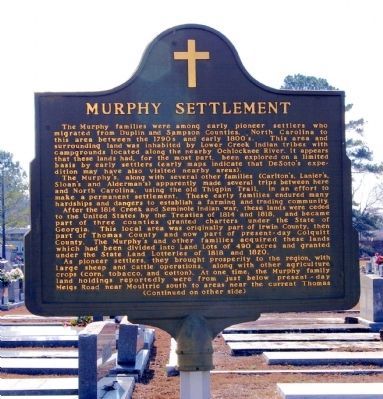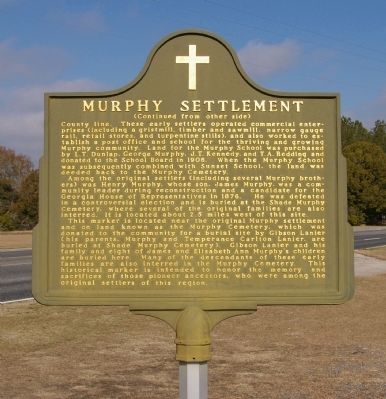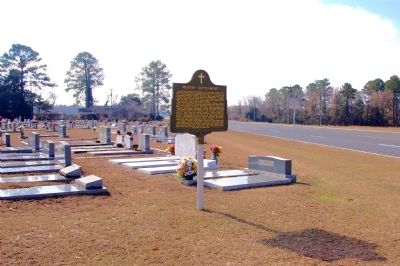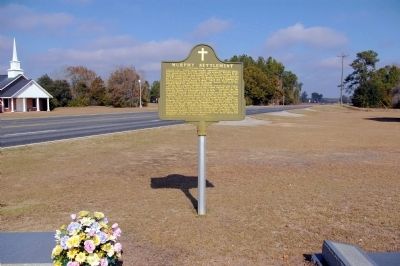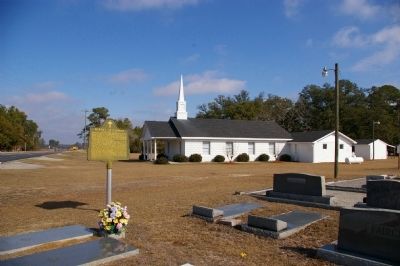Murphy Settlement
The Murphy families were among early pioneer settlers who migrated from Duplin and Sampson Counties, North Carolina to this area between the 1790’s and early 1800’s. This area and surrounding land was inhabited by Lower Creek Indian tribes with campgrounds located along the nearby Ochlocknee River. It appears that these lands, for the most part, been explored on a limited basis by early settlers (early maps indicate that DeSoto’s expedition may have also visited nearby areas).
The Murphy’s, along with several other families (Carlton’s, Lanier’s, Sloan’s and Alderman’s) apparently made several trips between here and North Carolina, using the old Thigpen Trail, in an effort to make a permanent settlement. These early families endured many hardships and dangers to establish a farming and trading community.
After the 1814 Creek and Seminole Indian war, these lands were ceded to the United States by the Treaties of 1814 and 1818, and became part of three counties granted charters under the State of Georgia. This local area was originally part of Irwin County, then part of Thomas County and now part of present-day Colquitt County. The Murphy’s and other families acquired these lands which had been divided into Land Lots of 490 acres and granted under the State Land Lotteries of 1818 and 1820.
As pioneer settlers,
they brought prosperity to the region, with large sheep and cattle operations, along with other agricultural crops (corn, tobacco, and cotton). At one time, the Murphy family land holdings reportedly were from just below present-day Meigs Road near Moultrie south to areas near the current ThomasCounty line. These early settlers operated commercial enterprises (including a gristmill, timber and sawmill, narrow gauge rail, retail stores, and turpentine stills), and also worked to establish a post office and school for the thriving and growing Murphy community. Land for the Murphy School was purchased by L.T. Dunlap, George Murphy, J.T. Kennedy, and T.A. Redding and donated to the School Board in 1906. When the Murphy School was subsequently combined with Sunset School, the land was deeded back to the Murphy Cemetery.
Among the original settlers (including several Murphy brothers) was Henry Murphy, whose son, James Murphy, was a community leader during reconstruction and a candidate for the Georgia House of Representatives in 1876. He was defeated in a controversial election and is burled at the Shade Murphy Cemetery, where several of the original families are also interred. It is located about 2.5 miles west of this site.
This marker is located near the original Murphy settlement and on land known as the Murphy Cemetery, which was donated to the community
for a burial site by Gibson Lanier (his parents, Murphy and Temperance Carlton Lanier, are buried at the Shade Murphy Cemetery). Gibson Lanier and his family and eight of James and Elisabeth Ann Murphy’s children are buried here. Many of the descendants of these early families are also interred in the Murphy Cemetery. This historical marker is intended to honor the memory and sacrifices of those pioneer ancestors, who were among the original settlers of this region.Topics. This historical marker is listed in these topic lists: Agriculture • Cemeteries & Burial Sites • Native Americans • Settlements & Settlers. A significant historical year for this entry is 1814.
Location. 31° 4.229′ N, 83° 49.426′ W. Marker is near Moultrie, Georgia, in Colquitt County. Marker is at the intersection of U.S. 319 and Mack Dekle Road, on the right when traveling north on U.S. 319. The marker stands at the edge of the Murphy Cemetery, adjoining the New Hope Free Will Baptist Church, opposite Mack Dekle Road. Touch for map. Marker is in this post office area: Moultrie GA 31768, United States of America. Touch for directions.
Other nearby markers. At least 8 other markers are within 8 miles of this marker, measured as the crow flies. Greenfield Church (approx. 3.6 miles away); Olde Greenfield Church and Historic Cemetery (approx. 3.6 miles away); Colonial Heights (approx. 5.9 miles away); Colonial Dames of America Centennial Sundial
Credits. This page was last revised on May 30, 2020. It was originally submitted on March 13, 2011, by David Seibert of Sandy Springs, Georgia. This page has been viewed 1,676 times since then and 102 times this year. Photos: 1, 2, 3, 4, 5. submitted on March 13, 2011, by David Seibert of Sandy Springs, Georgia. • Bill Pfingsten was the editor who published this page.
